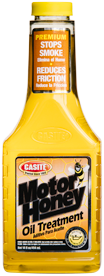How to Stop Your Car from Burning Oil
Burning oil is a common problem for car owners, especially if you own an older car or one with a lot of miles on the engine. But how do you fix the problem?
How Can I Tell If My Car Is Burning Oil?
Sometimes, you can tell that an engine is burning oil because you will see blue or gray smoke coming out of the tailpipe. That’s the most obvious, tell-tale sign.
However, even if you don’t see any smoke, your engine could still be burning oil. That’s because the car has a catalytic converter that is designed to clean the exhaust and prevent pollutants like smoke from reaching the outside air. Because of this, many (perhaps even most) cars that burn oil won’t produce any noticeable smoke.
Without smoke, how can you tell if your car is burning oil? Check the oil level. If the dipstick shows your engine oil is low, there are really only two options: either the oil is leaking out, or it is burning away inside the engine. If you park your car on a clean patch of pavement at night and in the morning there’s a new oil spot below it, you know the problem is a leak. If there’s no oil spot, the problem is burning oil.
What Causes an Engine to Burn Oil?
Your engine is always burning fuel within the cylinders, in a space known as the “combustion chamber.” Though oil is used to keep everything lubricated and prevent friction, the engine is designed to keep the oil out of the combustion chamber. If your car is burning oil, that means the oil is somehow getting into the combustion chamber, where it doesn’t belong.
There are a few ways that oil can get into the combustion chamber: worn piston rings or cylinder walls, worn valve seals, or a bad PCV (Positive Crankcase Ventilation) valve.
Is Burning Oil Really a Problem?
You’ll sometimes hear people say that it’s normal for an engine to burn oil. Whether they’re right or not depends on your definition of “normal.”
If by “normal” you mean “common,” then yes, burning engine oil is a pretty common problem, especially in older cars. But it’s still a problem, even if it’s common.
It’s not “normal” as in “your car is designed to do that.” In fact, it’s the opposite: your car is designed to prevent oil from burning, or at least not burn enough to really notice. If you’re burning so much oil that the level gets low between oil changes, that’s not “normal” in a good sense.
It’s not a problem you should ignore, either. Oil is important; it’s what keeps your engine from destroying itself as metal rubs against metal several dozen times per second. If the oil gets too low, it doesn’t provide that essential protection.
Even if you were to continually add oil to keep it from getting low, burning oil can still be a big problem. Remember the part about the catalytic converter having to deal with the smoke from burning oil? That smoke can eventually damage the catalytic converter and require it to be replaced. Catalytic converters contain precious metals such as platinum, and are therefore not cheap.
The smoke and soot can also lower engine power and MPGs, while increasing your exhaust emissions. It’s not good for the environment, and not good for your pocketbook.
How to Stop Your Engine from Burning Oil
Of the three main causes of oil burning, a bad PCV valve is the simplest one to fix. That’s because the other causes – bad piston rings, cylinder walls, and valve seals – are not easy to fix at all, and often amount to an engine overhaul. That’s expensive, and it takes your car out of commission for a while (you can’t drive it very far without an engine).
However, there is an easier option you can try. Instead of changing the parts inside your engine to make them more compatible with the oil, you can change the oil so that it is more compatible with the existing parts.
Motor Honey is an oil treatment that you add to your car’s regular motor oil. It’s designed to reduce oil burning (and the smoke that it sometimes causes) without having to make any changes to the engine itself. All you have to do is include one bottle with each oil change. It costs just a few dollars, and since it takes the place of about a half-quart of motor oil, it almost pays for itself right off the bat. It’s definitely a money-saver compared to adding oil between changes, and if it staves off an engine overhaul or a new catalytic converter, it could save you hundreds or thousands of dollars.
We’re not claiming that it’s magic or that it will always solve all your problems, but it’s so easy and inexpensive that it’s worth giving it a try.
You can pick up a bottle at any of these stores.

